Heartleaf skullcap is a spring beauty for central Texas
Native groundcover heartleaf skullcap (Scutellaria ovata) is in full, glorious bloom in my garden, showing off with abandon before retreating into dormancy for the summer.
I’ve paired it with Texas dwarf palmetto (Sabal minor) in the live oak-shaded island bed out front. It makes a blue-green carpet under the palmettos all winter, and with spring growth it nearly eclipses them. Once the skullcap dies back in summer, however, the palmettos will take center stage again.
Massing this plant is the key because a single 1-gallon will just get lost in your garden. Luckily, heartleaf skullcap loves to spread, both underground through its fleshy roots and above ground via seeds.
While aggressive, it is easy to pull up, plus it dies back during our hot summers, leaving room for other plants to shine.
I planted a swath in the back garden too, lining the path around the stock-tank pond. I’m enjoying it while it lasts!
All material © 2006-2014 by Pam Penick for Digging. Unauthorized reproduction prohibited.


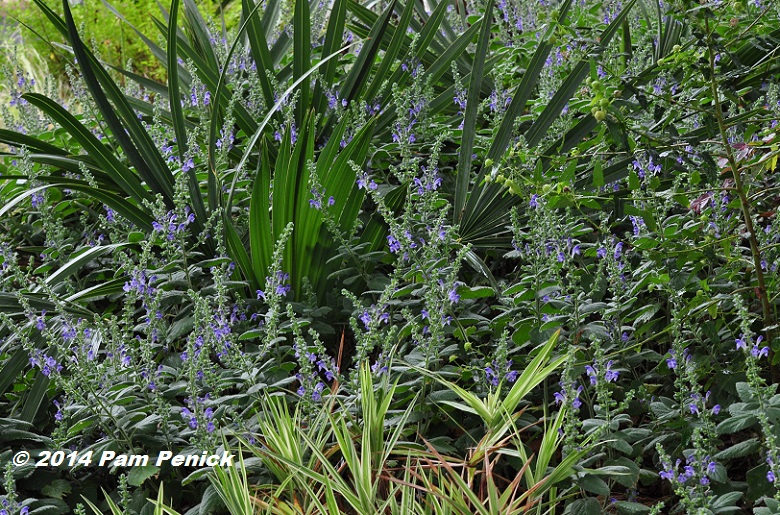
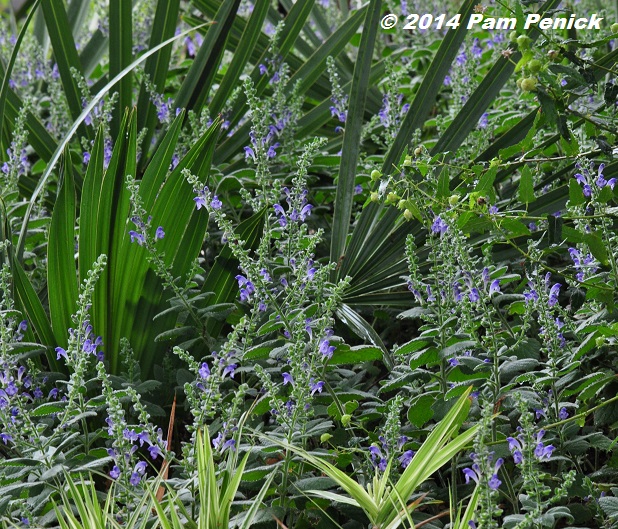
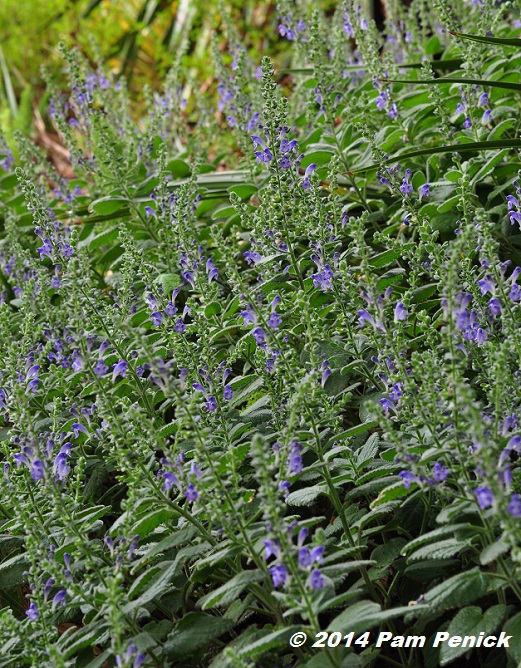
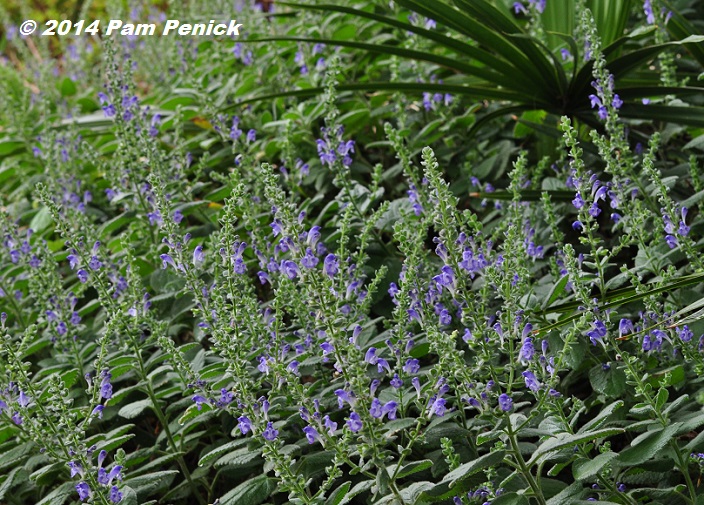
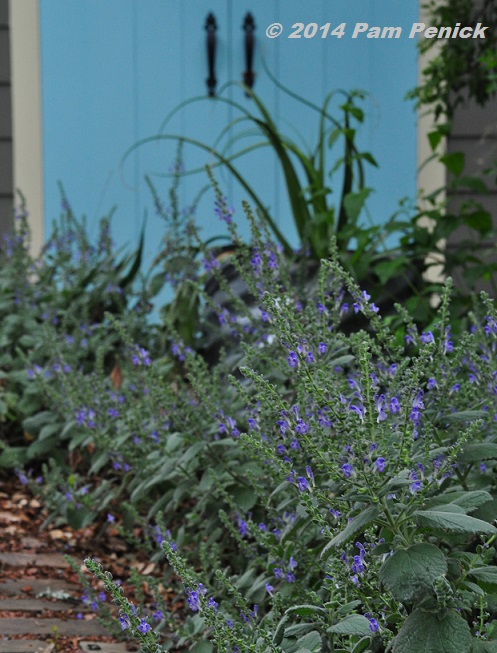
I planted a small 4″ pot of heartleaf skullcap in Fall 2012 in a spot that probably gets too much sun. It limped along last year against all odds and then popped right back up this fall/winter (spreading out in a circle from the original plant) and is blooming. I love the suggestion of planting it with palmettos. Any other suggestions of plants to pair it with that don’t take off until the summer when skullcap goes to sleep? Right now mine between a young Texas torchwood/ Gregg’s mistflower.
How about Turk’s cap, Katie? It also works well under black-and-blue sage (Salvia guaranitica), which is taller and leggier. It would also be a nice groundcover under a pruned-up Texas mountain laurel. —Pam
I love Heartleaf Skullcap for all the reasons you mention. It’s just so, so beautiful in both foliage and blooms. It is most striking in a mass, is easily controlled and is great paired with plants that are in their glory later in the growing season.
What are your favorite combos with heartleaf skullcap, Tina (per Katie’s question above)? —Pam
I love it with Turkscap. The Turkscap’s bright green leaves combine beautifully with the Heartleaf’s greyer leaves. When the Turks is dormant, the Heartleaf is growing (and spreading!). Once the Turks is in its glory, the Heartleaf is done for the season. Actually, I like Heartleaf with almost any plant that has a brighter green foliage–I just think it’s such a pretty combo. I have some under a Mt. Laurel (as mentioned above), though the Laurel could probably use a bit more pruning. It’s lovely.
I found it to be very invasive. Took me forever to finally get rid of it after I decided it wasn’t the right plant for an area.
Everyone has their own tolerance level for aggressive plants. I consider heartleaf skullcap aggressive but not invasive. It certainly is persistent, and I can see that you’d have to dig out the roots for a while if you decided to get rid of it. But “invasive,” to me, means it spreads widely and perniciously in the garden (or into the wild), and I don’t find that heartleaf skullcap does that. —Pam
LOVE this plant, which I learned about from your blog. Growth rate timing is perfect for covering mass sweep of narcissus blades after blooming. Pink guara peeks through the skullcap blooms. I like that the guara is airy looking while the skullcap is quite stocky and substantial.
Good tip, Sandy, for using it to hide spent narcissus leaves. —Pam
I am just beginning to try this plant in a few areas where I hope it will spread and provide early color and cover under and around later blooming tropical sage plants.
It sounds like heartleaf skullcap might pair nicely with lantana as well as Turk’s cap? Both of these are some of the last to leaf out and show off in my spaces, and both provide cover from the hottest summer sun while allowing winter and early spring light through.
I haven’t used it in full sun, Deb, so I can’t say how well it would do under lantana (assuming full sun for that). Definitely it would like the same conditions as Turk’s cap (dappled shade or morning sun), although in my island bed it hasn’t spread under the nearby Turk’s cap yet. —Pam
The lantana I’m thinking about are bird-planted and in dappled shade most of the year, only getting a blast of full afternoon sun in the mid to late summer due to the angle of the hill we are on. I’m want to try seeding in some spiderwort there and if it does well I’m guessing heartleaf skullcap would too? Maybe I’ll try both!
Mine is planted just out from under the tree canopy and gets dappled morning sun, mid-day shade, and late afternoon sun. It tends to get wilty out there if we haven’t had enough rain, and each year it’s moving itself toward the shade if that’s any help to you.
I have had heart leaf skullcap planted with Turks cap, Salvia guaranitia and Salvia madrensis in my back yard for several years now under the edge of the canopy of a live oak tree. It came back after this past harsh winter we had in the Dallas/Fort Worth area. I do not mind it spreading. I like that it is so tough and survives our extreme climates in Texas.
I’m glad to hear it does well in Dallas/Fort Worth too, Lorie. It’s a great little plant. —Pam
Heartleaf skullcap is one of my favorite cool weather plants, thriving while the heat lovers are taking their nap. Mine does well paired with oakleaf hydrangea and several crinum, both of which seem to benefit from the “cloud” of protection it provides during winter.
That sounds like a pretty combo, Vicki. —Pam